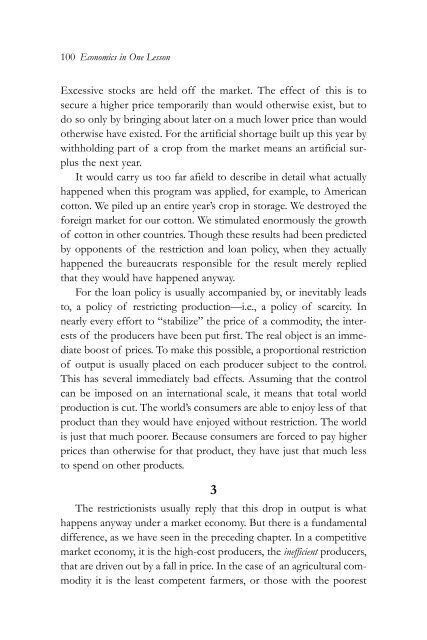1gDdM7w
1gDdM7w
1gDdM7w
- No tags were found...
Create successful ePaper yourself
Turn your PDF publications into a flip-book with our unique Google optimized e-Paper software.
100 Economics in One LessonExcessive stocks are held off the market. The effect of this is tosecure a higher price temporarily than would otherwise exist, but todo so only by bringing about later on a much lower price than wouldotherwise have existed. For the artificial shortage built up this year bywithholding part of a crop from the market means an artificial surplusthe next year.It would carry us too far afield to describe in detail what actuallyhappened when this program was applied, for example, to Americancotton. We piled up an entire year’s crop in storage. We destroyed theforeign market for our cotton. We stimulated enormously the growthof cotton in other countries. Though these results had been predictedby opponents of the restriction and loan policy, when they actuallyhappened the bureaucrats responsible for the result merely repliedthat they would have happened anyway.For the loan policy is usually accompanied by, or inevitably leadsto, a policy of restricting production—i.e., a policy of scarcity. Innearly every effort to “stabilize” the price of a commodity, the interestsof the producers have been put first. The real object is an immediateboost of prices. To make this possible, a proportional restrictionof output is usually placed on each producer subject to the control.This has several immediately bad effects. Assuming that the controlcan be imposed on an international scale, it means that total worldproduction is cut. The world’s consumers are able to enjoy less of thatproduct than they would have enjoyed without restriction. The worldis just that much poorer. Because consumers are forced to pay higherprices than otherwise for that product, they have just that much lessto spend on other products.3The restrictionists usually reply that this drop in output is whathappens anyway under a market economy. But there is a fundamentaldifference, as we have seen in the preceding chapter. In a competitivemarket economy, it is the high-cost producers, the inefficient producers,that are driven out by a fall in price. In the case of an agricultural commodityit is the least competent farmers, or those with the poorest


